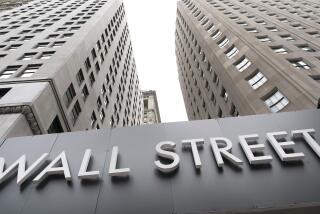Wait-and-See May Be Best Stock Strategy for Now : Markets: It depends on specific circumstances, of course, but most experts say that long-term investors shouldn’t be in a rush to sell.
- Share via
Sell, buy or wait?
That’s today’s $64,000 question following Friday’s startling 190-point thumping in the Dow Jones industrial average.
The answer depends a lot on what kind of investor you are and how much risk you’re willing to take, investment advisers say. If you’re a long-term investor and have no immediate need for your money tied up in stocks--and you don’t think you’re smart enough to correctly “time” market swings--you’re probably better off not doing anything, many say.
You might even consider buying if stocks fall far enough.
But if you need the cash or have a weak heart, you might be better off bailing out and cutting your losses. If you bought a while ago, you’d still have nice profits because the market is still up more than 20% for the year.
Of course, no one knows for sure what is going to happen today and later this week, except that activity will almost certainly be wild and woolly.
Some analysts predict that this correction will be short-lived, arguing that the economy is fundamentally sound, interest rates are stable and stocks are not overvalued.
While stocks may not rebound for weeks to the record levels set last Monday, they are not likely to fall precipitously and stay down for a protracted time either, these optimists say. If there is any sign of a replay of 1987, they add, the Federal Reserve will make good on its pledge Sunday to step in and provide enough liquidity to the economy and banking system to ease any cash squeeze and drive interest rates lower, boosting stocks.
“The correction will be all over by late Monday or sometime Tuesday,” said Peter Anderson, president of IDS Advisory Group, a Minneapolis money management firm.
But others disagree, arguing that Friday’s tailspin was only the beginning of a possibly devastating bear market. They cited the end of takeover fever, weakening corporate profits and a number of statistical factors that show that stocks are overvalued.
Takeover speculation alone may have contributed as much as 10% to 20% of the market’s overall value, these experts say. And the economy is not in as good shape as widely believed, with the overhang of massive corporate debt and new threats of rising inflation.
“You should treat (today) as if it’s a disaster in the offing,” said Robert T. Gross, editor of Professional Investor, a Pompano Beach, Fla., newsletter.
Which view will emerge as correct is anyone’s guess.
“It’s really a tough call. . . . Either way, you take the risk of being wrong,” said William E. Donoghue, an investment adviser and author in Seattle.
That uncertainty is a principal reason why long-term investors ought to stay put and ride this turmoil out, advisers say.
First, over almost any time span of 10 or more years, stocks have consistently outperformed inflation and safer investments such as certificates of deposit or Treasury bills. Wild swings like Friday’s simply come with the territory.
Indeed, calm seemed to be the attitude of many long-term investors polled on Friday. “At this point, I’m not deeply concerned. Since I’m a long-term investor, I’m not going to get excited. I’ll ride it through,” Ernest Harden, owner of a computer software and consulting business in Jacksonville, Fla., told the Associated Press.
Second, as the 1987 crash experience showed, trying to sell quickly in a panic poses a number of risks. If you own stocks through stock mutual funds--as do many small investors these days--you may not know exactly what price you will get when you place your order.
That’s because funds typically give you the price (net asset value of the fund) at the close of that day’s trading if you place your order before trading closes, or the price of the next trading day’s close if you order after the close. In a volatile market, you won’t have any idea what that closing price will be. Just ask anyone who sold early Friday when the market was only down 25 points, or anyone who tried to sell early in the day on Oct. 19, 1987.
You also run the risk of being whipsawed--that is, selling at one price only to see the market rebound later. This risk applies especially to those setting so-called stop-loss orders that specify a price at which your stock should automatically be sold. Indeed, many small investors who panicked and sold on Black Monday in 1987 saw the market rebound the next two days. Those who stuck it out have gained nicely since then.
You also run the risk that your orders may not be processed as quickly as you would like. So quick was the 1987 plunge that many stop-loss orders were not executed at all, or at the price specified. The New York Stock Exchange and the National Assn. of Securities Dealers, which operates the over-the-counter market, have both implemented systems since 1987 designed to ensure that small orders are handled quickly in the event of another crash.
But both of these additions remain untested in a real crash, said John Markese, research director for the American Assn. of Individual Investors. If there is a rerun, there are no assurances that brokers or dealers will honor their commitments under those systems, he contends.
Under what conditions should you consider selling? Certainly if you need money soon (although, in that case, you shouldn’t have been in the market in the first place). Also you should consider selling if you are interested in taking short-term profits or if you can’t stomach the current volatility.
“A lot of people have (accumulated) a lot of profits since the beginning of year; it wouldn’t hurt to take those,” adviser Donoghue said.
The trick is sell the right things at the right time.
It may not be prudent to sell everything. Many advisers suggest selling stocks that have been driven up on takeover speculation, although they already lost considerable value in Friday’s rout.
“If you bought on fundamentals, then sell on fundamentals,” says John P. Graner, regional director for Prudential-Bache Securities in Los Angeles.
There are some stocks you might want to keep. Merrill Lynch on Friday advised investors to stay in energy, health care, pollution control and capital goods-related issues.
If you are in mutual funds and want to stay conservative, consider keeping funds--such as utility, equity income, or growth and income funds--that invest in stocks paying high dividends. Those high payouts will cushion those funds from falling as much as the rest of the market.
Assess what happened in the Japanese and Asian stock markets today for clues as to what will happen later in the U.S. markets, but be aware that overseas markets were bound to drop anyway in response to Friday’s U.S. tumble.
And when you sell, try to avoid selling at the bottom. Remember the principal adage of investing: Buy low, sell high. Look for a rebound after any big selloff; there almost always is at least a temporary bounce after a steep fall as bargain hunters enter the fray.
If you have a mutual fund, consider waiting toward the end of that day’s trading to see what happens, because you will get the day’s closing price anyway. To be safe, give yourself 90 minutes before the close to get your order in, Prudential-Bache’s Graner says.
You also should take steps to ensure that that your orders are processed as quickly as you would like.
Mutual fund and brokerage companies have increased the number of phone lines to deal with any panic, in response to numerous problems in the hectic days during and after the 1987 free fall. For example, Fidelity Investments, the nation’s largest mutual fund firm, and Charles Schwab & Co., the biggest discount brokerage, said they added extra telephone order takers this weekend to handle an expected increase in calls.
But whether extra phone lines will be enough to handle another mass panic remains to be seen. Be prepared to stay on the line.
The same risk of delays may hold with individual stocks. Call your broker to let him or her know you’re around; if you can’t get through, visit in person. That contact may be especially critical if you have a margin account--the type of account where you buy shares using funds borrowed from the brokerage, with the stocks used as collateral.
In the 1987 crash, many investors received “margin calls”--requests for more money or collateral--because the value of their stocks fell. Investors who did not respond quickly may have seen their holdings liquidated by their brokerages against their will. Brokerages generally allow only 48 hours for you to meet a margin call before they will liquidate--even if you can’t be reached, Prudential-Bache’s Graner says.
Under what conditions should you consider buying?
Of course, you want to buy when stocks have bottomed, but timing that accurately will be difficult if not impossible. The bottom could be reached sometime today, or it could be months from now. In the 1987 episode, the Dow Jones industrial average did not bottom out until Dec. 4, some six weeks after Black Monday.
If you’re not confident when that bottom will occur, consider using dollar cost averaging. In that strategy, you invest set amounts of money at set intervals--say, $1,000 a week for the next 10 weeks--rather than buying all at once.
Also, look to other investments that will do well if stocks are shaky.
Among of the best may be long-term Treasury bonds and zero-coupon Treasury bonds. Their prices rose sharply Friday--just as they did in the 1987 crash--thanks to the typical investor “flight to quality” and anticipation that a stock selloff would prompt the Federal Reserve to ease monetary policy and drive down interest rates. Long-term bonds rise when interest rates fall.
RELATED STORIES, A1
More to Read
Inside the business of entertainment
The Wide Shot brings you news, analysis and insights on everything from streaming wars to production — and what it all means for the future.
You may occasionally receive promotional content from the Los Angeles Times.










